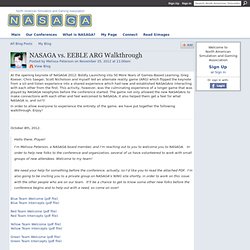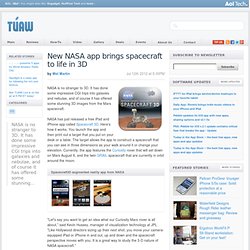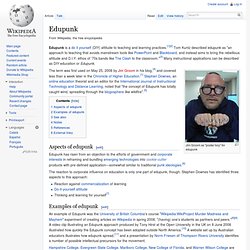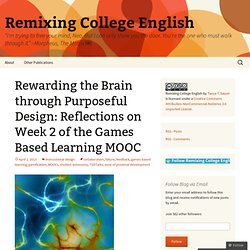

ARIS - Mobile Learning Experiences - Creating educational games on the iPhone. Home page - Aurasma. Home » Dear Esther. Vs. EEBLE ARG Walkthrough - North American Simulation and Gaming Association. At the opening keynote of NASAGA 2012: Boldly Launching into 50 More Years of Games-Based Learning, Greg Koeser, Chris Saeger, Scott Nicholson and myself led an alternate reality game (ARG) which flipped the keynote from a sit-and-listen experience into a shared experience which had new and established NASAGAns interacting with each other from the first.

This activity, however, was the culminating experience of a longer game that was played by NASAGA neophytes before the conference started. The game not only allowed the new NASAGAns to make connections with each other and feel welcomed to NASAGA, it also helped them get a feel for what NASAGA is, and isn't! In order to allow everyone to experience the entirety of the game, we have put together the following walkthrough. Enjoy! October 8th, 2012: Hello there, Player! *Spoilers* The answers to the 4 puzzles can be found by highlighting the blank spaces below: Blue Team: Push your own consulting and books November 7th, 2012: November 8th, 2012: New NASA app brings spacecraft to life in 3D.
NASA is no stranger to 3D.

It has done some impressive CGI trips into galaxies and nebulae, and of course it has offered some stunning 3D images from the Mars spacecraft. NASA has just released a free iPad and iPhone app called Spacecraft 3D. Here's how it works. You launch the app and then print out a target that you put on your desk or a table. The target allows the app to construct a spacecraft that you can see in three dimensions as your walk around it or change your elevation. Your IF Competition Voting Page. 1st place Andromeda Apocalypse Marco Innocenti Floating in space on a strange vessel, sole survivor of a world... and maybe of the entire human race, Ektor Mastiff must find a way through the cosmos, on a voyage that can change the history of mankind forever.

Play, download, or learn more about this game on the IFDB 5th place Sunday Afternoon. The 18th Annual Interactive Fiction Competition. Interactive Fiction Interview. Edupunk. Edupunk is a do it yourself (DIY) attitude to teaching and learning practices.[1][2] Tom Kuntz described edupunk as "an approach to teaching that avoids mainstream tools like PowerPoint and Blackboard, and instead aims to bring the rebellious attitude and D.I.Y. ethos of ’70s bands like The Clash to the classroom.

"[3] Many instructional applications can be described as DIY education or Edupunk. Jim Groom as "poster boy" for edupunk The term was first used on May 25, 2008 by Jim Groom in his blog,[4] and covered less than a week later in the Chronicle of Higher Education.[1] Stephen Downes, an online education theorist and an editor for the International Journal of Instructional Technology and Distance Learning, noted that "the concept of Edupunk has totally caught wind, spreading through the blogosphere like wildfire".[5] Aspects of edupunk[edit] The reaction to corporate influence on education is only one part of edupunk, though.
IF Interactive Fiction. Minecraft PE. Okay, so I have a confession to make.

I have never seen Minecraft before (I've heard about it, but I must have been stuck under a rock for the past 10 years because I have never looked into it until today). Wow, I feel so relieved to get that off my chest. So in researching about the game I came across Jacob (a six year old playing the game) and his parents taped him playing Minecraft: One of the conversations I have been having with other math instructors is the "need" for algebra for students who are not focusing in a profession that is math heavy. Being a math instructor I cannot urge the importance of math for many of the science, computer, engineering, etc. fields. If you think about it, we don't force scale memorization or interval practice for all students, since they will be listening to music throughout their life.
Do we need to force content on those that don't need to have it? Rewarding the Brain through Purposeful Design: Reflections on Week 2 of the Games Based Learning MOOC. For me, the standout resource from the second week of the Games Based Learning MOOC was Tom Chatfield’s TED Talk “7 Ways Games Reward the Brain.”

Chatfield’s seven aspects of gaming align with many of the same aspects of gaming that were addressed during our discussion of fun, flow, and fiero during the first week, and I think that a consideration of his arguments regarding not only how but why games are so rewarding will help shed even more light on the issues I addressed in my last post regarding how games-based learning continues to trump classroom-based learning, despite how (poorly) gamified school already is (see my post on bad game design for a more thorough discussion of this).
The Relationship between decisions and experience Chatfield’s first reward is experience bars measuring progress. He argues that it’s important for players to be able to see how close they are to their long-term objective, as well as how far they’ve come since they started the game. Best content in Apps AR-and-ARGs. Why is the Princess in Another Castle? · ScottMeunier. Gender considerations in game-based learning design. Roads of Rome.